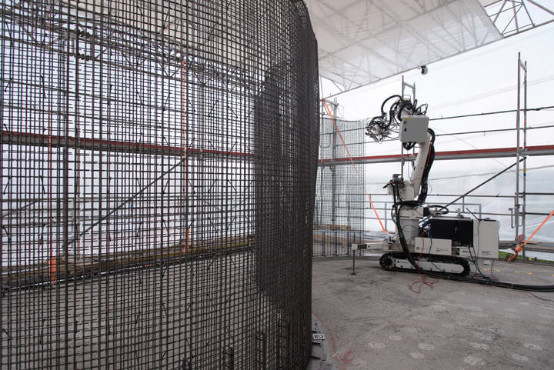The house can also be used by Swiss scientists to build houses with 3D printing and robots.
According to the Digital Trends website, eight students from the Swiss Federal Institute of Technology in Zurich are implementing a bold plan to develop a new generation of architectural robots. The proof-of-concept products they developed are building a 200-square-foot housing DFAB House on the campus of the ETH Zurich. The project uses a range of advanced technologies, including 3D printing , modular construction, and new construction methods. DFAB House is considered to be the first home in the world to be designed, planned and built primarily using digital processes. Matthias Kohler, a professor at the Federal University of Zurich, said, “In contrast to construction projects that use only one digital construction technology (such as 3D printed homes), DFAB HOUSE combines a new set of digital construction techniques. This allows us to take advantage of each technology and the synergy between them." According to Digital Trends, the new technology includes a robot called the In Situ Fabicator I, which is mounted on a tracked vehicle and can be fitted with a dense mesh. The robot is dust-proof, waterproof, and uses European-standard electricity as an energy source, connected to the Internet, allowing architects and builders to modify the construction process at any time and in real time. Once the wall has hardened, the integrated ceiling made by a large 3D printer will “appearâ€. This "Mesh Mould" technology won the Swiss Technology Award at the end of 2016. The two- and three-story single rooms are simultaneously manufactured at the Robotics Construction Laboratory at the ETH Zurich – using construction robots to assemble wood and concrete components. In addition to testing the performance of new construction and energy technologies in real-world applications, Digital Trends said the project also enables the team to design future robotic solutions. The current In Situ Fabricator I robot is too heavy to enter many standard buildings. It can only handle objects weighing up to 88 pounds (40 kg). Scientists hope to increase this number to over 130 pounds (59 kg). The team has designed and produced a new generation of robotic arms that can handle heavier objects with the same precision and reliability. DFAB House is part of the Digital Construction Project of the Swiss National Research Competence Center. DFAB House is not the first engineering project to use 3D printing technology , and construction projects across Europe are actively using 3D technology. A robot developed by the Massachusetts Institute of Technology is said to be able to "print" the entire home within 14 hours. However, integrating digital design, planning, and digital construction processes is a bold step toward making the construction process more sustainable and efficient, while enabling architects and builders to control their construction projects in real time. DFAB House is scheduled to be completed in the summer of 2018 and will be used as a place for visiting and working with visiting researchers at the NEST project. Source: Digital Trends Stainless Steel Pet Scissors,Pet Curved Cutting Scissors,Pet Safety Scissors,Pet Magasin Scissors Zhangjiagang Mister Tools Co., Ltd , https://www.mingshitools.com


